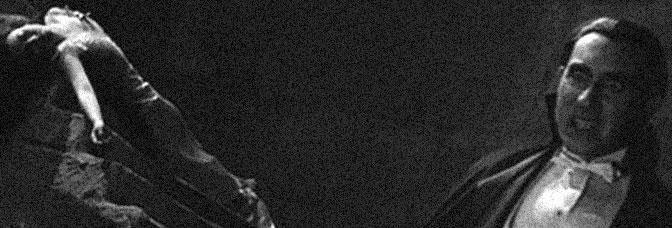A lot of Drácula’s hundred minute runtime is spent with Eduardo Arozamena talking really slow to José Soriano Viosca and Barry Norton. Arozamena’s Professor Van Helsing (so nice to have such a familiar “brand” you can just talk about the characters and assume some passing familiarity) and Viosca and Norton are the guys who need to believe him about vampires. Dracula–played by Carlos Villarías–is after Norton’s fiancée Lupita Tovar. Viosca’s her father, though the film never really does anything with it.
Viosca and Norton are basically just around to hear Arozamena’s exposition. Director Melford does all right with it, actually. He seems to understand how much information they’re conveying because he usually breaks it up with some of Pablo Álvarez Rubio’s antics (as Renfield). Through some luck, screenwriter Baltasar Fernández Cué understands Rubio’s importance in the film. He opens the picture, he introduces the viewer not just to Villarías but to himself. Rubio is the only actor in the film to get a scene (or two) to himself. Everything else in the picture involves regular cast members. And Rubio’s really likable. It makes him a great tormented victim.
So Drácula is long. There’s no music and very little ambient sound. It’s often just watching Villarías walk around (in what appears–oddly–to be a London After Midnight homage). Melford’s lucky to have Tovar, who’s able to get enough sympathy from the audience just from her performance because there’s really not much character in Cué’s script.
As Tovar’s friend, Carmen Guerrero only gets two scenes and the script gives her more character. She’s good too (or gives the impression of having the ability to be good, but the film dumps her early).
Besides Norton, who’s terrible, and Viosca, who’s ineffective, Drácula is well-acted. Villarías’s got to play a walking, talking monster, which–when the film doesn’t give any character to said monster–might be the specific problem of Dracula adaptations, and he does stumble. But Melford gets a genuinely creepy conclusion when he finally kidnaps Tovar.
Tovar’s great. Did I already call her out?
Arozamena’s kind of fun as Van Helsing. He almost plays it like a comedy.
There are some editing problems (cutting in the footage from Tod Browning’s English language problems Dracula), but Arthur Tavares does well with this version’s footage. And George Robinson’s photography is magnificent. He’s so graceful Melford’s often employed dolly shots come off well.
Drácula’s pretty good. Not great, but pretty good.
 ★★½
★★½
CREDITS
Directed by George Melford; screenplay by Baltasar Fernández Cué, based on the screenplay and play by Hamilton Dean, John L. Balderston and Garrett Fort and the novel by Bram Stoker; director of photography, George Robinson; edited by Arthur Tavares; produced by Carl Laemmle Jr.; released by Universal Pictures.
Starring Carlos Villarías (Conde Drácula), Lupita Tovar (Eva), Barry Norton (Juan Harker), Pablo Álvarez Rubio (Renfield), Eduardo Arozamena (Van Helsing), José Soriano Viosca (Doctor Seward), Carmen Guerrero (Lucía), Amelia Senisterra (Marta) and Manuel Arbó (Martín).
THIS POST IS PART OF THE HOLLYWOOD’S HISPANIC HERITAGE BLOGATHON HOSTED BY AURORA OF ONCE UPON A SCREEN.
RELATED


Leave a Reply to Andrew WickliffeCancel reply